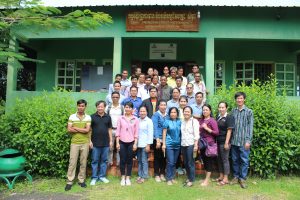 This year, Cambodia REDD+ Programme is honored to be selected as a study tour destination by Lao PDR REDD+ Programme. Delegates from Lao found this study a fruitful experience as they learned insight knowledge from Cambodia REDD+ Programme on Institutional arrangement, stakeholder engagement, safeguard, benefit sharing, livelihood development, and forest law enforcement.
This year, Cambodia REDD+ Programme is honored to be selected as a study tour destination by Lao PDR REDD+ Programme. Delegates from Lao found this study a fruitful experience as they learned insight knowledge from Cambodia REDD+ Programme on Institutional arrangement, stakeholder engagement, safeguard, benefit sharing, livelihood development, and forest law enforcement.
Cambodia REDD+ Taskforce and its Secretariat hosted the visit from 17-21 October 2016 and welcomed 17 Lao delegates from Ministry of Agriculture and Forestry, Ministry of National Resource and Environment, Lao Women Union, Civil Society Organizations-SNV, and Development Partners -the World Bank.
H.E Dr. Chheng Kimsun welcomed the delegates at Forestry Administration, and was very pleased to share lesson learned on Cambodia REDD+ programme. He also addressed that “Although Cambodia is at an advanced stage of REDD+ Readiness Phase and has a clear institutional framework, the programme has to put more efforts in building institutional capacity for the coming Implementation phase. To achieve this, we also need to learn from the other Countries as well”. The team met Cambodia REDD+ experts to share experiences related to REDD+ progress and challenges each country faced in implementing REDD+ programme.
After visiting Cambodia REDD+ Programme at the national level, the delegates visited Keo Seima Wildlife Sanctuary REDD+ Project in Mondolkiri Province. The project just recently sold forest carbon credits worth 2 million US dollars to Disney under Voluntary Carbon Market, and has ground practical experience in forest and national resource management.
Mr. Kong Puthyra, Representative of Department of Environment, Mr. Yeang Donal, Seima REDD+ Specialist from WCS, and local communities provided insight experience on forest management, and drew some keys strategies toward achieving the project. This includes effectively engage local communities and authorities in all planning and implementation processes; strengthen law enforcement to reduce illegal logging and encroachment; improve local livelihood to reduce pressure on forest demand; facilitate community land titling process; practice safeguard procedure, and develop benefit sharing framework that responds to both local needs and REDD+ principles. The latter one is being finalized with local community to get their consents and feedbacks, and to ensure their concerns and needs are reflected in the design.
Although Keo Seima Wildlife Sanctuary REDD+ Project is relatively small in scale, its successes and challenges can inform a better REDD+ design at the National level. Anolay Vongsouthi, REDD+ Project Manager for SNV, found this tour a useful experience. He is delighted to see Cambodia’s progress in REDD+ program and project, especially having a clear REDD+ Institutional framework, inclusive stakeholder engagement process, and safeguard and benefit-sharing framework. He believes that these experiences would bring back to Lao PDR for further development of REDD+ Program.
The last activities of the tour was meeting with local community, and Indigenous People to understand their practices in managing community resources, and visited some community based eco-tourism sites.
